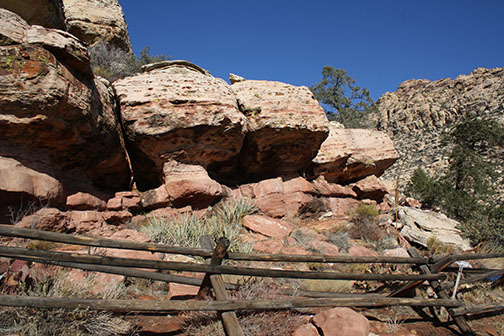
A challenge of the holidays is finding activities to entertain out-of-town visitors or easily-bored children. An easy answer might be a winter visit to one of Red Rock Canyon National Conservation Area’s multitude of trails.
The Lost Creek Children’s Discovery Trail will interest people of any age, but is especially good for those new to hiking or visiting the park for the first time. Elevation gain in this one-mile loop is only 200 feet, but keep in mind that very young children might struggle with the uneven, rocky terrain.
Along the way you will find evidence of prehistoric use by American Indians, interesting plant communities, and a short spur trail which leads into a box canyon with a seasonal waterfall.
The well-marked trailhead lies on the parking area’s west side. Follow the path just a few minutes and it will dip down and cross Red Rock Wash, a major drainage. If rain threatens, save this hike for another day, for this innocent-looking wash can quickly fill with a raging torrent.
After crossing the wash, the trail heads up the rocky slope and into a highly-vegetated area, mostly of manzanita, scrub oak, juniper and pinyon pines. It is interesting to note that in the Lost Creek area alone, you can find five of the eight plant communities found in the park. The ones found here are desert wash, chaparrel, cliff, riparian and blackbrush shrub communities.
Prehistoric American Indians used the Lost Creek area as a seasonal camp, and the evidence remains along the first half of the trail. The first place, marked by a sign, was once a well-used agave roasting pit. Such prehistoric kitchens were used not only to roast agave hearts, but also for other vegetables and meats. The basic idea of the roasting pit was to build a fire and then add pieces of rock. When coals were formed, food was placed on the bed of coals and heated rock and then covered with vegetation and soil to cook slowly.
Continue along the trail as it ascends and then traverses the hill and you will come to a fenced area on your right. If you take the time you will be able to make out some faint pictographs here, rock writings which are painted onto the rock surface rather than pecked in like the more common petroglyphs.
Soon after this area look for the spur trail to your right, which is signed “seasonal waterfall,” and head upstream. The undulating section of trail heads through dense vegetation and in a few places it is hard to find where the trail is and you will need to do a bit of route finding. One place especially appealing to children is where the trail heads under an enormous boulder which is wedged high up against another boulder, creating a roof.
Emerging from this natural rock fall you will come to the box canyon and Lost Creek Falls. Last week I found a steady stream of water pouring off the 50-foot cliff face, which feeds a nice pool of water below. From now through March is the best time to see water at this pour-off.
After enjoying the grotto, return to the spur’s junction with the main trail, and go right to continue the loop. In just a couple of minutes you will arrive at an elevated wooden boardwalk which was constructed to protect this riparian area. Look over the railing and you will be able to see Lost Creek, canopied by willow trees and flanked by other water-loving plants including grasses, rushes, grapes, horsetails and even watercress. What you probably won’t see, though is the tiny southeastern Nevada springsnail, which makes a home at Lost Creek, and very few other places in the world.
Some benches here make a fine place to take a break and perhaps ponder for awhile how fortunate you are for making the choice to visit such a lovely place. When you have drunk your fill of nature’s peace, continue down the trail, back over the wash to the parking area, and home.
Deborah Wall is the author of “Base Camp Las Vegas, Hiking the Southwestern States,” “Great Hikes, A Cerca Country Guide,” and co-author of “Access For All, Touring the Southwest with Limited Mobility.” Wall can be reached at Deborabus@aol.com.